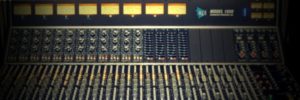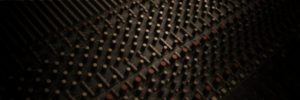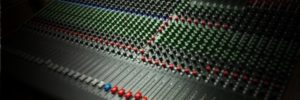Analog Warmth: Mixing Consoles
May 24, 2018
It’s funny that we sometimes don’t appreciate what we have until it’s gone — and then we spend lots of time and energy to get it back! And we are really happy when we get it back.
That’s the story with analog warmth. When all there was were consoles and tape machines, everyone complained that the consoles “colored the sound” and that tape machines were too noisy and non-linear. And that one day all of these “problems” would be solved in the all-digital age.
But as soon as digital music production began to mature, audio professionals complained that everything sounded thin, sterile, small, hard, and unpleasant. Top producers and engineers longed for their colorful, saturating vintage gear that they once cursed.
And so it is. Now we have the best of both worlds. Digital transparency with vintage character and analog warmth.
Tape, tubes, transistors, and transformers (the 4 T’s!) are the foundations of analog warmth. And we now have amazing replicas and modern interpretations of these classic colors thanks to Universal Audio, Slate Digital and others.
CONSOLES
When I started my professional audio career, you had to have a console. And producers and engineers had very strong opinions about which ones they liked best. Sometimes it was workflow, but usually, it was the sound.
These days we no longer have to spend hundreds of thousands of dollars on huge large format consoles, cables, maintenance, and space. We have fantastic software emulations that capture all of the musicality, personality, and quirks of our favorite analog consoles thanks to UAD, Slate and others.
In our world-famous Mixing Foundations course, we spend an entire week immersing ourselves in console color and saturation with these amazing plugins — learning how and when to use them to get amazing repeatable results.
SSL dominated dance and pop, while Neve, API, and Harrison were favorites for rock. But why? Well, it has a lot to do with two things: the “filter footprint” and the transformer saturation characteristics.
The filter footprint is a non-linear contour of the console frequency spectrum — and each console model is a bit different in this regard. Some filter off a lot of HF — like vintage Neve and Harrison — making sounds round and warm. Other consoles trim a bit of low end which creates a tight and bright sound.
Second is the consoles’ transformer personality. Transformers slow down transients and compress the signal making the sound fat and thick. Transformers influence the dynamic character of the console as well. Some have a big, slow-moving LF response, while others have a very dynamic and tight LF response.
Reflecting on the most popular consoles that we are currently using (as plugins) in our Mixing Program, I made a little chart for your reference with my “tasting notes”.
Vintage Neve

Vintage Neves come in lots of variety, but the overall vibe is a hushed high end, a smooth long-ringing midrange and a wide, slow-moving wall of vague but warm low end. Works wonderfully for smoothing out harsh and thin sounds. It does not get any warmer than vintage Neve.
Modern Neve

Modern Neve, like the 88 has the signature slow-moving low end of Neve but with a much more open, unfiltered high-frequency response. Great for slow and mid-tempo HD modern sounding productions, but still very warm and smooth.
API

Tight and bright, with a smooth but not very dynamic low-end response. The signature Jensen transformers compress the low end and the high end in a very musical and clear way. Clarity is a characteristic of API. A wonderful console for pop, rock, and film.
SSL E

Expensive, classy British crunch with excellent low-frequency dynamics. The SSL E console is bright, with a pleasant mid-range crunch, and a full, dynamic low end. A goto console for dance and electronic music with a very radio-friendly sound.
Harrison

Extremely smooth and clear. No crunch at all, no long-ringing harmonics. Tight and smooth, and very, very warm due to its hushed almost LPF high-frequency character. Dynamically it sort falls in between API (very tight) and Neve (very loose)
Trident

Sort of a specialty item for me. Noisy, bright and on the thin side – but very dynamic, I like this console for vocals and acoustic guitars, indy rock, and retro projects.
Console emulation plugins play a huge role in the mixing workflow that we teach in Mixing Foundations and Our Mixing and Mastering Courses.
Stay connected with news and updates!
Join our mailing list to receive the latest news and updates from our team.
Don't worry, your information will not be shared.


